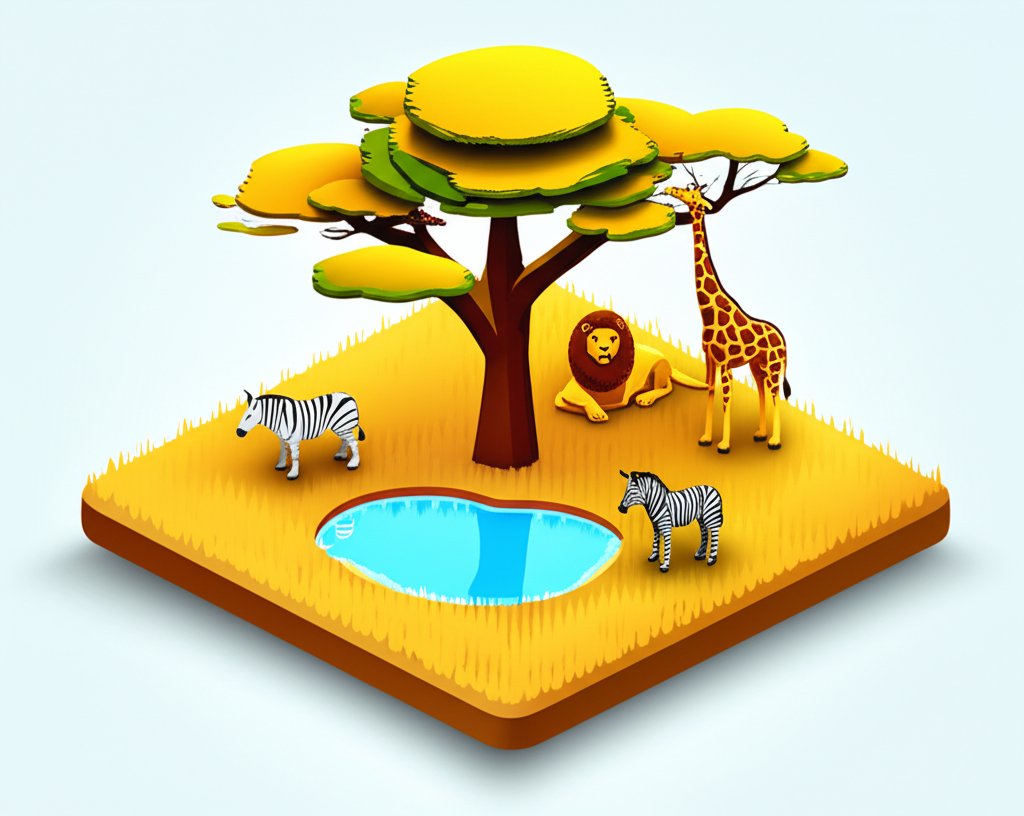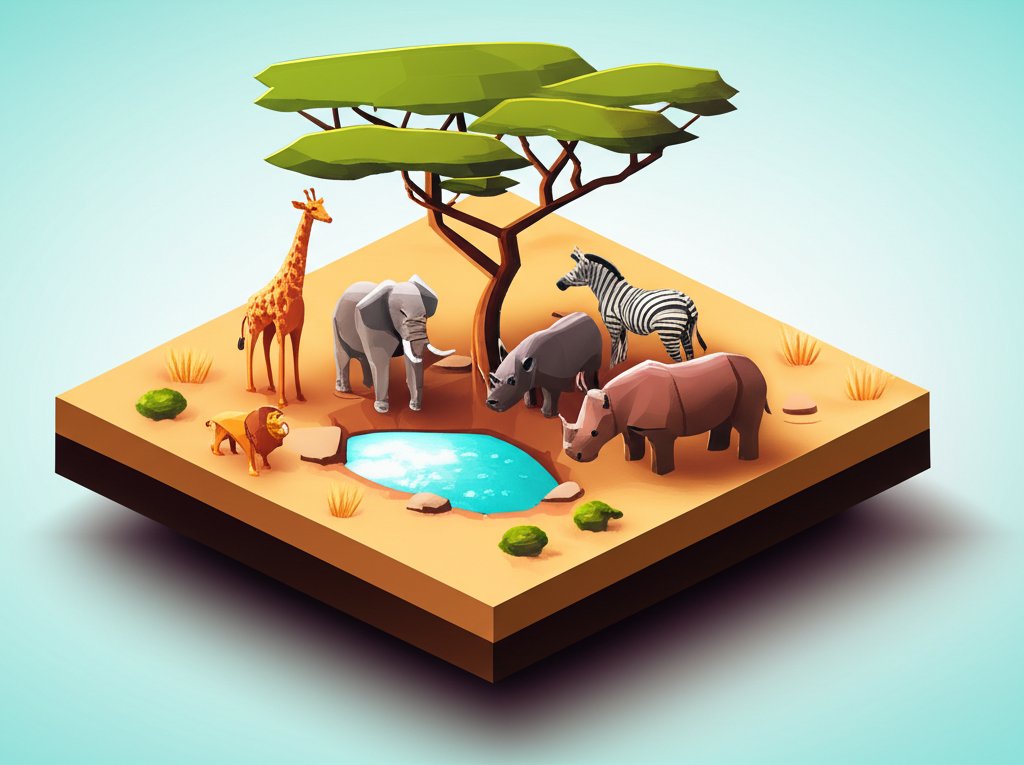Welcome to the breathtaking heart of Africa! The African Savanna, a vast and vibrant expanse, is far more than just dry grasslands and scattered trees. It’s a dynamic ecosystem teeming with life, where every detail tells a story of survival, adaptation, and endless wonder. If you’re looking for fun facts about the African savanna, you’ve come to the right place. From epic migrations that defy imagination to the cunning strategies of its iconic inhabitants, this article will reveal savanna interesting facts that will leave you awestruck. Prepare to discover the incredible savanna habitat facts as we delve into the secrets of one of Earth’s most captivating biomes, offering interesting facts about the savanna that truly stand out, and providing a comprehensive guide to facts about the savanna in Africa that will make you an instant expert.
The African Savanna: A Habitat of Epic Scale and Enduring Climate

The African Savanna is a realm of superlatives, where nature’s grand design is displayed on a monumental canvas. Understanding its sheer scale and the rhythm of its seasons is key to appreciating its unique charm.
Unrivaled Size: The World’s Largest Tropical Grassland
Did you know the African Savanna isn’t just large, it’s the world’s largest tropical grassland? Covering nearly half of the entire African continent, this immense biome stretches across nations like Tanzania, Kenya, Botswana, and Zambia. Its sheer size means it supports an unbelievably vast array of life, thriving in a landscape that has evolved over millions of years. In fact, some geological estimates suggest parts of the African Savanna ecosystem are over two million years old, a testament to its enduring resilience. This colossal scale is one of the most compelling facts about the savanna in Africa, making it a truly unique natural wonder.
A Climate Defined by Dramatic Seasons, Not “Endless Summer”
While it’s true that the savanna experiences consistently warm temperatures year-round, often soaring above 90 degrees Fahrenheit (32°C), it does not have a perpetual “endless summer.” Instead, the African Savanna is characterized by two distinct, dramatic seasons: a wet season and a dry season. The wet season brings heavy, often torrential, rainfall, typically lasting for six to eight months (around 500 mm to 1,270 mm annually), which transforms the landscape into a lush green paradise. Conversely, the dry season can last for up to seven months, bringing little to no rain, causing grasses to wither and water sources to shrink. This pronounced seasonal shift is one of the most interesting facts about the savanna, dictating the life cycles and migratory patterns of its inhabitants.
The Open Canopy: Why Savannas Aren’t Forests (Mostly)
Unlike dense forests where canopies interlock, the African Savanna is defined by its open tree canopy and a continuous, often tall, grass understory. This unique structure allows ample sunlight to reach the ground, which is crucial for the growth of the diverse grasses that dominate the landscape. The scattered trees, such as the iconic acacia and baobab, are widely spaced, preventing them from forming a closed canopy. This fundamental difference is a core savanna habitat fact, distinguishing it from other biomes. Interestingly, in some regions, particularly where rainfall is higher or fire is less frequent, the tree density can increase to the point where a savanna might even be temporarily classified as a woodland or forest, highlighting the dynamic nature of this ecosystem.
Remarkable Life: Unveiling African Savanna Wildlife Wonders

The African Savanna is synonymous with incredible wildlife. Its vast plains are a stage for some of nature’s most spectacular displays and ingenious adaptations. Here are some fun facts about the African savanna’s amazing inhabitants.
The Great Migration: Earth’s Most Spectacular Journey
One of the most awe-inspiring savanna interesting facts is the Great Wildebeest Migration. This isn’t just a casual trek; it’s the largest overland migration of mammals on Earth. Every year, over 1.5 million wildebeest, joined by hundreds of thousands of zebras and gazelles, embark on a perilous journey across the Serengeti and Maasai Mara ecosystems in search of fresh grazing lands and water, driven by the seasonal rains. This epic circular journey covers over 1,800 miles (2,900 km), facing river crossings laden with crocodiles and plains patrolled by big cats. It’s a testament to the savanna’s capacity to sustain such immense numbers of herbivores and the intricate dance between predator and prey.
Masters of Adaptation: Surviving the Savanna’s Extremes
Life on the savanna demands incredible resilience, and its animals are masters of adaptation.
The Apex Predators: Lions, Cheetahs, and Hyenas
The African Savanna is renowned as the ultimate hunting ground for some of the world’s most formidable predators.
Flora’s Resilience: The Secret Life of Savanna Plants
The plants of the African Savanna are just as remarkable as its animals, having evolved incredible strategies to survive its harsh, seasonal conditions. These savanna habitat facts reveal their hidden strengths.
Drought-Defying Trees: Baobab, Acacia, and Eucalyptus
The scattered trees that dot the savanna are true survivors.
Grass: The Unsung Hero of the Ecosystem
While big trees get a lot of attention, the true foundation of the African Savanna is its grass. It’s not just a uniform green carpet but a diverse array of species, often growing up to 10 feet (3 meters) tall in the wet season. This rapid growth provides the primary food source that sustains the vast herds of herbivores, from tiny gazelles to massive elephants. The tough, fibrous composition of many savanna grasses also helps them withstand intense grazing and frequent fires, regenerating quickly from their roots. Without this abundant and resilient grass, the savanna as we know it simply wouldn’t exist, making it a crucial component of interesting facts about the savanna.
Dynamic Forces: Fire, Change, and Conservation in the Savanna
The African Savanna is a constantly evolving landscape, shaped by natural forces and increasingly influenced by human activity. Understanding these dynamics is essential for appreciating the future of this magnificent biome.
Fire: The Essential Architect of the Savanna Landscape
One of the most vital yet often misunderstood savanna habitat facts is the crucial role of fire. Fire is not just a destructive force but a natural and necessary architect of the African Savanna. Frequent, low-intensity wildfires, often sparked by lightning, prevent the encroachment of dense forests by clearing away woody shrubs and saplings. This maintains the open grassland environment essential for grazers. Fire also returns nutrients to the soil, stimulating fresh, nutritious growth of grasses after the burn. Many savanna plants have adapted to survive fires, with seeds that require heat to germinate or roots that can quickly resprout. Ecologists now use controlled burning as a key management tool to mimic natural processes and maintain the health and biodiversity of the savanna.
The Savanna is Constantly Evolving (and Expanding!)
The African Savanna is not static; it’s a living, breathing landscape that is always changing. One intriguing fun fact about the African savanna is that some savanna areas are actually expanding. For instance, the Sahara Desert savanna, a transition zone, is experiencing shifts in its boundaries. Climate change, altered rainfall patterns, and human activities like overgrazing or changes in fire management can all influence this expansion or contraction. These factors can disrupt the “regeneration niche” of dominant tree species, affecting their ability to grow and impacting the savanna’s overall structure and species composition, making the study of facts about the savanna in Africa an ongoing scientific endeavor.
Unseen Heroes: Decomposers and the Circle of Life
Beyond the charismatic megafauna, the savanna relies heavily on its unsung heroes: the decomposers. This is an often-overlooked but truly jaw-dropping African savanna fun fact. Organisms like termites build colossal mounds, aerating the soil and enriching it with nutrients. They, along with dung beetles, swiftly break down organic matter, preventing disease and recycling vital nutrients back into the ecosystem. Vultures and hyenas act as the savanna’s cleanup crew, efficiently consuming carcasses and preventing the spread of pathogens. This intricate “circle of life” ensures that no energy or matter is wasted, underpinning the health and vibrant productivity of the entire savanna ecosystem.
Conclusion
The African Savanna is a world of unparalleled natural beauty and ecological complexity. From its majestic, two-million-year-old expanses to the delicate balance between predator and prey, drought-resistant flora and vital fire, every aspect offers fun facts about the African savanna that captivate and inspire. We’ve explored savanna habitat facts that highlight its vastness and unique climate, uncovered savanna interesting facts about its iconic wildlife and resilient plants, and shared interesting facts about the savanna’s dynamic forces and unseen heroes.
Understanding these facts about the savanna in Africa not only deepens our appreciation for this remarkable biome but also underscores the critical importance of conservation efforts. It’s a land of constant movement, incredible adaptation, and endless discovery—a true jewel of our planet that deserves our unwavering protection for generations to come.
FAQ Section
Q1: What defines an African savanna biome?
A1: An African savanna biome is a tropical grassland ecosystem characterized by warm temperatures year-round, distinct wet and dry seasons, and widely scattered trees that do not form a closed canopy, allowing sunlight to reach a continuous understory of tall grasses. This open structure is a key savanna habitat fact.
Q2: How big is the African savanna?
A2: The African savanna is the world’s largest tropical grassland, covering nearly half of the entire African continent. Its vastness makes it a critical habitat for millions of animals and plants, making its scale one of the most impressive facts about the savanna in Africa.
Q3: What are some iconic animals that live in the African savanna?
A3: The African savanna is famous for its incredible biodiversity. Iconic animals include large herbivores like wildebeest, zebras, elephants, giraffes, and various antelopes, as well as formidable predators such as lions, cheetahs, leopards, and hyenas. This rich wildlife is a source of many fun facts about the African savanna.
Q4: What is the climate like in the African savanna?
A4: The African savanna experiences consistently warm temperatures throughout the year, but its climate is defined by two distinct seasons: a wet season with heavy rainfall (typically 500-1270 mm annually over 6-8 months) and a prolonged dry season with very little rain. This seasonal rhythm is an interesting fact about the savanna’s climate.
Q5: Why is fire important in the savanna habitat?
A5: Fire is a natural and essential element of the savanna ecosystem. It helps maintain the open grassland by preventing trees and shrubs from becoming too dense, promotes new, nutritious grass growth by returning nutrients to the soil, and reduces the risk of larger, more destructive wildfires. This makes fire management a crucial savanna habitat fact.
Q6: How do plants survive the long dry season in the African savanna?
A6: Savanna plants have developed remarkable adaptations to survive the dry season. Many trees, like the baobab, store water in their trunks. Others, like acacia, have deep taproots to reach groundwater, small leaves or thorns to reduce water loss, and some shed their leaves entirely. Grasses often die back to the ground but regrow quickly from their roots when the rains return, showcasing more savanna interesting facts.
Q7: Is the African savanna expanding or shrinking?
A7: The status of the African savanna is complex and varies by region. While some areas face threats from desertification, habitat loss, and climate change, certain savanna regions, particularly those bordering deserts like the Sahara, are in fact expanding due to various environmental and climatic factors. This dynamic nature is one of the more complex facts about the savanna in Africa.
Q8: What is the Great Migration?
A8: The Great Migration is one of the most spectacular wildlife events on Earth, an annual journey of over 1.5 million wildebeest, along with zebras and gazelles, across the Serengeti and Maasai Mara ecosystems. They migrate in a circular pattern, constantly seeking fresh grazing lands and water, driven by the seasonal rains. It’s a prime example of fun facts about the African savanna and its incredible biodiversity.










